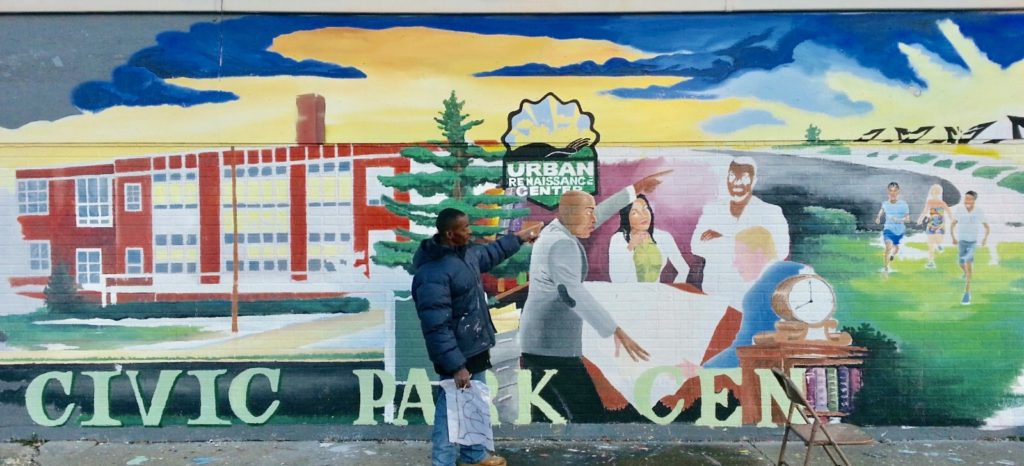
Muralist Cardine Humes at his work in Civic Park (Photo by Harold C. For
By Harold C. Ford
Well I came upon a child of God…
And I asked him, Tell me where are you going
This he told me…
We are stardust, we are golden
“Woodstock” by Crosby, Stills & Nash
Returning from an East Village Magazine assignment, I came upon a “child of God” in the personage of Cardine Humes painting an outdoor wall mural in cold winter weather. His modest collection of paint supplies were contained in a brown paper sack; his ladder was a well-used folding chair.
Humes, 47, is an aspiring artist commissioned by the Urban Renaissance Center (URC) to paint a scene that depicts renewal initiatives in Flint’s Civic Park neighborhood. His mural-in-progress graces the exterior wall of the Dort Meats Co. at 2414 Dupont St. Company co-owner Michael Howay said he welcomes the project as a symbol of neighborhood renovation.
“For years we’ve been trying to get someone to do a mural capturing the Civic Park scene,” said Sherman McCathern, URC executive director and pastor of the nearby Joy Tabernacle. “The mural is capturing the transition from what happened in decline and now the resurgence and rebirth.”
Civic park centennial
Civic Park will celebrate its centennial in 2019. “We’re getting ready and building up to that centennial,” said McCathern. “This was a prominent neighborhood back in the day. This is one of the oldest neighborhoods, if not the first planned subdivision in America.”
Civic Park’s original boundaries were first laid out by a Boston landscape architect in 1917. Significant development of the neighborhood occurred in the first two decades of the 20th century aided by the Modern Housing Corporation (General Motors Corporation) and the DuPont Company. A New York architectural firm, Davis, McGrath, and Kiesling designed most of the original buildings. Civic Park provided housing for GM employees working at nearby factories. Construction was completed in 1919-1920.
Civic Park was a thriving neighborhood from its creation through the 1970s. However, the disappearance of GM jobs, economic recession, and depopulation led to the deterioration and abandonment of hundreds of homes.
Blighted homes, historic site:
When McCathern’s fledgling congregation found a permanent home at 2505 N. Chevrolet Ave. in 2009, a gothic structure formerly occupied by the Community Presbyterian Church for 85 years, he lobbied government officials to tear down dilapidated and abandoned homes. His campaign was hindered by Civic Park’s historic site designation.
Civic Park was designated an Historic Residential District in 1979. “It is one of the largest historic sites in America,” said McCathern.
The historic district boundaries correspond to the original Civic Park development as first laid out in 1917. According to McCathern, Civic Park boundaries are currently: Pasadena Avenue on the north to Welch Boulevard on the south; Dupont Street on the east to Brownell Boulevard on the west.
Houses within an historic site cannot be torn down willy-nilly as they are protected by federal law. Nonetheless, McCathern and others argued that, “A lot of these homes have lost their historical significance.” The government eventually agreed.
“We will allow for one of the first times in American history,” McCathern said he was informed by government officials, “to go into a federal protected area and take some of the homes off of the historic site because they’ve lost their structural integrity.”
“Integrity was the (key) word,” recalled McCathern. The National Register Bulletin defines integrity as “the ability of a property to convey its significance.” A 2013 report by the consulting firm ICF International concluded that 54% of the properties in the Civic Park historic district lacked “integrity.”
Teardown
Thus, the teardown and boarding up of dilapidated and abandoned buildings in the Civic Park neighborhood began in earnest. “We recently did $5 million of demolition in this area,” said McCathern.
Joy Tabernacle partnered with West Flint Nazarene Church and nonprofit Flint Forward to board up vacant structures. “We boarded together over 1,000 homes,” said McCathern.
Buildup
Rebuilding the Civic Park neighborhood includes partners such as the Genesee County Land Bank, Habitat for Humanity, the University of Michigan-Flint, and the Ruth Mott Foundation (RMF).
URC was one of the initial grantees following RMF’s adoption of a 2016-2020 strategic plan that focuses on north Flint. RMF’s grant-giving priorities, informed by a series of community forums, are youth, safety, economic opportunity, and neighborhoods.
“The University of Michigan-Flint has agreed to walk alongside the Urban Renaissance Center for the next ten years bringing every one of their disciplines from the school to bear on what would happen,” said McCathern. “One of the projects was how we’re going to get a mural capturing Civic Park before transition and what we perceive it to be.”
Mural

Muralist Cardine Humes (Photo by Harold C. Ford)
Humes’ mural likely touches on all four of RMF’s strategic plan priorities and is intended to convey a message of hope. A file cabinet at the center of the mural is filled with plans for a better future. Community leaders are gathered around a conference table discussing ideas for a better neighborhood. One leader points in the direction of an envisioned new park for children.
“The message is dawn of a new day, children gonna’ come out and play,” said Humes. “The clock says it’s time for the kids to be able to come out and play in the neighborhoods safely.”
Humes estimated that he’s spent hundreds of hours on the project. Some paints and financial support have been provided by URC whose mission is “to support the socioeconomic empowerment, civic engagement, and holistic wellness of urban children, youth, and families.”
Rebound:
The mural symbolically represents a rebound for the Civic Park neighborhood and artist alike. Five months ago Humes transplanted himself from the south. “I moved up here for my 12-year-old daughter,” he said. Simultaneously, he is building lapsed relationships with his mother, brothers, and sisters.
Humes fully intends to set down roots, make Flint his new home, become a renaissance man that contributes to the renaissance of his newly adopted community.
“I’m gonna’ set a life, build this house, squat if I have to, take care of the plumbing, get the doors on now, start a studio, clear the hallways, and polish the floors, and open the doors,” he exclaimed without taking a breath. “I’m just going to clean it up, I’m going to make it where I can just draw.”
The love for his family and Joy Tabernacle, his adopted church, is obvious as is his passion for art. “She taught me art,” Humes said of his grandmother.
“I’ve been doing this all my life; it’s inbred in me,” he said when asked what motivates him. “Excitement,” he added, “the adrenalin rush to want to see it finished. I just can’t wait to see the end outcome. I just wanted to do something for you guys.”
“And we’ve got to get ourselves back to the garden…”
EVM Staff Writer Harold C. Ford can be reached at hcford1185@gmail.com.


You must be logged in to post a comment.